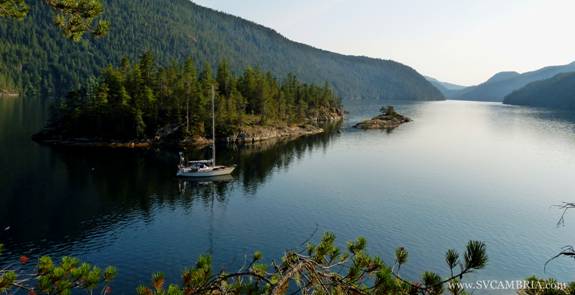Disclaimer: This blog article is not to be used for navigation. It is purely an account of our personal experience in and around the Desolation Sound area of British Columbia
It seems ironic that Captain George Vancouver chose the name Desolation Sound for what's now one of British Columbia Vancouver Inside Passage , that's what he found – desolation. The scene is much different today, especially during the summer months when thousands of boaters visit the area to enjoy its protected anchorages, warm-water swimming, fresh-water lakes and mountain views.
The actual park boundary lies to the west of Sarah Point
Moving in a counter-clockwise direction from Sarah Point
The entrance is clear but narrows down to about 300 feet before opening into a large anchorage with plenty of swing room in depths of 2 to 10 metres (6 to 33 feet). Like most destinations in Desolation Sound, the sea water is warm enough for swimming right off the boat but, if you prefer fresh water, there's a half-mile trail at the head of the bay that leads to a lake, just make sure you're willing to share your space with garter snakes before taking a dip to cool off. If walking is more your speed, there's a trail that leads to Isabel Bay
Located along Lancelot Inlet and within the park boundaries, Isabel Bay
The main anchorage is behind Madge Island Polly Island
Prideaux Haven, Desolation Sound Marine Park
It's no exaggeration when I say Prideaux Haven is the most beautiful anchorage in the area, but it's also the busiest. So, if you prefer to avoid the crowds, it's best to visit before mid-June or after Labor Day weekend.
The entrance to the anchorage looks more difficult on paper than it is in reality: The channel is narrow but clear with depths of 5 metres (16 feet) at low tide. If you're still not convinced, follow the advice laid out in "A Dreamspeaker Cruising Guide: Desolation Sound" and line up with the park sign on Williams Islands before turning to starboard and entering between Lucy Point (Eveleigh Island) and the Oriel Rocks.
Once inside, there's plenty of room to anchor throughout the large bay with good holding in mud in depths of 6 to 18 metres (20 to 60 feet) and protection from all quadrants. Other options include Melanie and Laura Coves as well as several bights outside of Cobblestone and Roffey Islands
It's not difficult to find ways to pass the time in Prideaux Haven with plenty of islets, lagoons and bays to explore by kayak or dinghy. In the summer, the water is warm enough for swimming, especially in the shallow lagoon located off Cobblestone Island
The entrance to Roscoe Bay Black Lake
For a more strenuous hike, there's a trail that leads to the top of Llanover Mountain Roscoe Bay
If you're running low, someone has piped water in from one of the streams. The hose is attached to a boat fender along the northern shore near a small waterfall. Avoid taking water after a heavy rainfall and always boil it before drinking.
Located on the northeast side of West Redonda Island Walsh Cove Marine Park
To enter, approach from the south between West Redonda and Bluff Point (Gorges Islets). We've seen boats go through False Passage at high water but don't recommend this approach because of underwater rocks (which are visible at low tide). The anchorage itself is deep and steep-sided, so most people anchor along West Redonda Island
Unfortunately, Walsh Cove isn't well-charted and cruising guides offer little additional help. The Canadian chart book 3312 has no detail, neither does our primary chartplotter, CMap (which is a commercial program). And Navionics has the information all wrong, listing depths of 10 metres (33 feet) in areas where there's approximately 20 metres of water (66 feet) and 5 metres (16 feet) for 10 metres (33 feet) (though all three show the general contour of the anchorage).
Teakerne Arm has two must-see attractions: the best fresh-water lake in the Desolation Sound area and a 100-foot waterfall, both located in the northern arm.
Temporary anchorage can be found along the northwest shore in depths of 10 to 20 metres (33 to 66 feet) or near Cassel Falls
To access the lake, take the dinghy to the park dock that sits at the eastern end of the northern arm. There you'll find a short trail that leads to the top of Cassel Falls
Von Donop Inlet, Cortes Island
Because of its long, narrow, twisting shape, Von Donop Inlet (Hàthayim Provincial Marine Park Cortes Island
The entrance shoals down to less than 2 metres (6.5 feet) at its narrowest point, and there's a rock mid-channel about half way through which can be seen at low tide. When approaching, favour the southwest side and keep the rock to port. Note: There's a saltwater lagoon in the northeast corner of the inlet that pushes a lot of current into the main channel, particularly during mid-tides.
There are several bights and coves along the 3-mile inlet that make good anchorages, but the best (and most popular) is at the head where there's plenty of swing-room and access to the park's hiking trails. The holding is good in mud throughout the inlet in depths of 4 to 12 metres (13 to 40 feet).
Access to hiking trails* can be found along the eastern shore at the head of the basin. The trails are located just beyond the outhouse and are unmarked, making things a little confusing. If you take the trail on the right, it eventually leads to an old fishery and the main road. If you turn left and continue walking another mile or so, you'll end up at Squirrel Cove where there's a general store and restaurant. The trail to the left leads to the lagoon. The lagoon can also be explored by dingy or kayak, but the entrance becomes a waterfall as its ebbing and entering and exiting (neither of which we've done) is recommended at high-water slack.
*There are aggressive wolves in the area that also use the trails.
It's possible to enter the bay on either side of Jane Islet, but the southern route is wider with fewer obstructions. Anchorage
Entrance to the anchorage is straight-forward, but it shallows up quickly close to shore. The holding is fair to good in hard sand and gravel with depths of 2 to 20 metres (6 to 66 feet). Protection from the northwest can be found throughout the park with southerly protection at the head of Drew Harbour
The nearby Heriot Bay Inn (by the ferry terminal) has a garbage dump (for a fee), propane, fuel, a restaurant and a pub (all good food), laundry and moorage. There's a popular hamburger stand just up from the public wharf, a TruValue grocery store on the corner of Heriot Bay Road Heriot Bay



















7 comments
I'm surprised the water gets warm enough to swim in. For some reason, I had in my head that the waters never warmed up sufficiently.
ReplyDeleteIn Desolation Sound the water runs around 70 to 77 degrees during the height of the summer because of the limited tidal flush, but I don't swim here -- too many jelly fish in the water!
DeleteWe're in Laura cove now (next to Prideux Haven) and the water is 75. A bit chilling but perfect for cooling off in the 80 degree weather. Grace Harbor yesterday was 72 water, but an even hotter air temp.
DeleteNo jelly fish in Laura cove. Saw 1 in Grace but not the bad kind.
You are giving such great information and overviews that you should get paid for your articles! :-) Wish I was going to cruise in Desolation Sound!
ReplyDeleteThanks, Liesbet. I've written a few articles for a local online magazine and was going to sell them this one but decided to keep it in the end.
DeleteWe've just returned from Desolation and did a lot of swimming- very few jelly fish to be seen (I don't swim with them either!) you've added a few new areas to explore next time- Walsh sounds heavenly- we spent a day in Laura cove- the rope swing made it worthwhile but so packed! Thanks for the beautiful pics and great descriptions!
ReplyDeleteYou'll love Walsh Cove. It still gets busy in the height of the summer but it's quieter than anchorages like Laura Cove.
Delete